Aplectrum hyemale, puttyroot orchid, is rare/endangered in NJ and is an unusual native perennial herbaceous plant in that its photosynthesis time does not overlap with the bloom time.
Flowers
Inflorescence/Flower cluster:
 The Aplectrum hyemale, puttyroot orchid, in spring, produces a single erect unbranched stem with flowers along the upper portion. Each flower is attached to the stem with a stalk (pedicel) so the arrangement is termed a raceme. The raceme can have 7 to 15 flowers. There are no active leaves during the flowering season although some withered leaves may still be around.
The Aplectrum hyemale, puttyroot orchid, in spring, produces a single erect unbranched stem with flowers along the upper portion. Each flower is attached to the stem with a stalk (pedicel) so the arrangement is termed a raceme. The raceme can have 7 to 15 flowers. There are no active leaves during the flowering season although some withered leaves may still be around.
The flower photos were taken during the 3rd week of May.
Individual Flower:
The Aplectrum hyemale plant has small flowers that are about half inch across and are greenish, yellowish, or whitish with magenta/purple markings.
Like all orchids, Aplectrum hyemale has 3 sepals and 3 petals. The sepals which are the longer ones are about a half inch long. The specialized petal - the lip - is whitish with some magenta marking and some lumpy ridges and up curved wavy edges. No spur extends from the back. The column is the reproductive structure with both male and female parts. The two upper petals tend to arch over the column
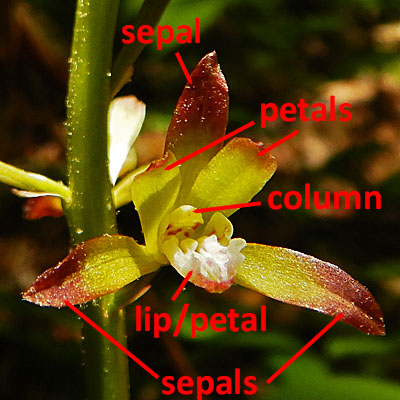
Here is a closer view of the column. At the tip of the column is the anther. The yellow pollen is encased in sacs called pollinia. There are 4 pollinia. The pollinia and its associate parts, together is called a pollinarium.
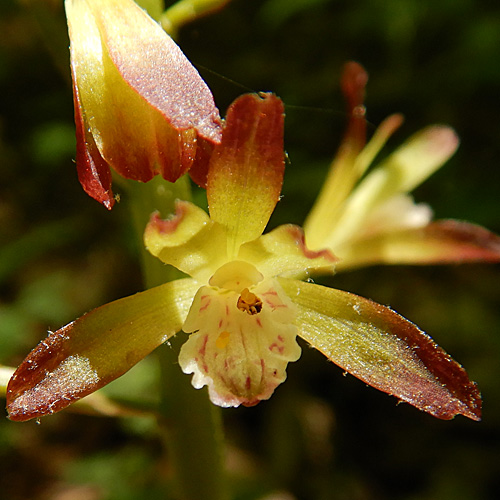
Below are two close ups. The 4 pollinia at the tip of the column can be seen in the first photo. The second gives another view of the flat column. The stigmatic surface is recessed on the underside of the column.

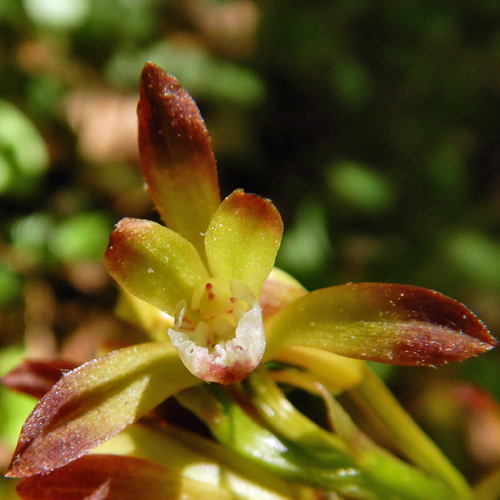
First photo below is a side view - several structures can be seen: lateral lobes of the lip, flower stalk (pedicel), inferior ovary (ovary below the sepals), and bracts where the pedicels meet the stem. The flower stalk is short and most of the length between the attachment and the sepals is the ovary. Note that there is a twist in the pedicel. Interestingly most orchid flowers twist about 180 deg. so that the mature flower has the lip on the bottom (towards the ground) and the column on the top. This process is called resupination and is a response to gravity when the flower is in the bud stage. The second photo is a top view.
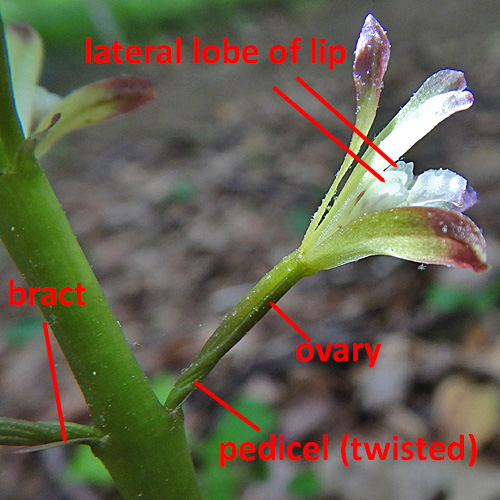

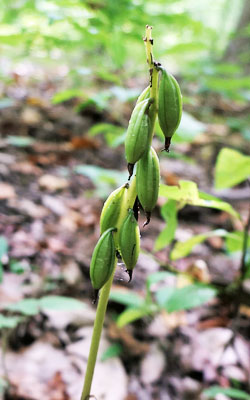
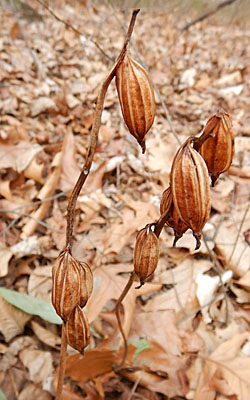
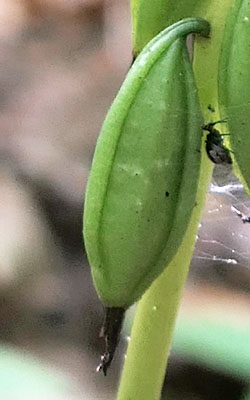
Pollination
Aplectrum hyemale, puttyroot orchid, offers very little rewards to attract insect pollinators. It doesn't have fragrance or nectar. It appears that the plant relies heavily on self-pollination, and or agamospermous (producing seed without fertilization) as well as vegetative reproduction. Low variability in the species has been found.
Leaves
The puttyroot orchid leaf is dark green or bluish green with distinctive parallel whitish veins on the upper surface and has a lumpy appearance. It is about 7 inches long and lies almost flat on the ground. There is a single leaf per plant. In the late summer/early fall long after the plant has bloomed, the single leaf emerges and persists through the winter. It will wither or almost be withered by the time the flower stem appears in spring. You need to remember the location of the leaves in order to find the flowers in spring. Plants do not flower each year but plants with large leaves are more likely to produce flowers.
Studies have shown that the leaves take advantage of the sunniest time of the year for the plant on the ground to photosynthesize (deciduous trees have not leafed out yet) to generate food storage for flowers and fruits later. At the same time the plant also takes advantage of the high soil moisture and high nutrient levels from the decomposing leaf litter. It flowers when the amount of light reaching the plant is much lower.
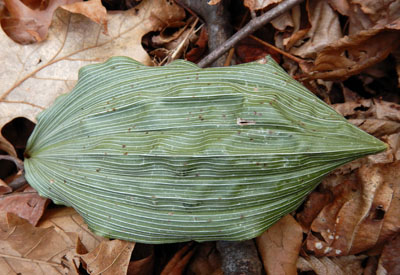
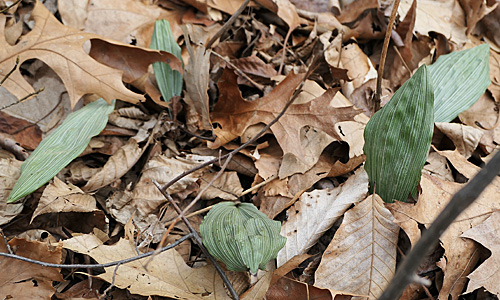

Plant - Habitat

Underground, the plant has usually 2 corms (vertical, fleshy, underground stem for storage of food) about 1 inch across, sometimes three. They are connected by short rhizomes (horizontal underground stems that can send out roots and shoots) about 1 inch. Each corm lasts 2 years and a new one is produced each year.
The single leaf grows from the oldest corm in late summer/early fall, over-winters and may produce a flower stem in the following spring after the leaf withers. The single erect stem in the spring grows to 1 to 2 feet tall without leaves. At the top of the stem is the raceme of flowers.
In terms of rarity/endangered in NJ it is rated S1 (most rare). NJ DEP cites locations in Sussex, Warren and Somerset Counties (2019).
The habitat includes rich mesic, deciduous woodlands.

Text by Millie Ling and all photos by Hubert & Millie Ling. Photos: Somerset County, NJ, Flowers: May 25, 2022; leaves: March 30, 2022
Additional information
Additional information / references:
- The Explorer at NatureServe shows Aplectrum hyemale distribution and rarity in the US and other information. The report was done in 1984, by now, 2023, the plant is most likely even less common. https://explorer.natureserve.org/Taxon/ELEMENT_GLOBAL.2.131051/Aplectrum_hyemale.
- New England Plant Conservation Program, Aplectrum hyemale, Puttyroot https://www.nativeplanttrust.org/documents/28/aplectrumhyemale.pdf
- NJ DEP Aplectrum hyemale June 3, 2019 Aplectrum hyemale Rare Plant Profile
- www.eFloras.org: Flora of North America https://floranorthamerica.org/Aplectrum_hyemale
- www.MissouriPlants.com: Aplectrum hyemale page - good photos https://www.missouriplants.com/Aplectrum_hyemale_page.html